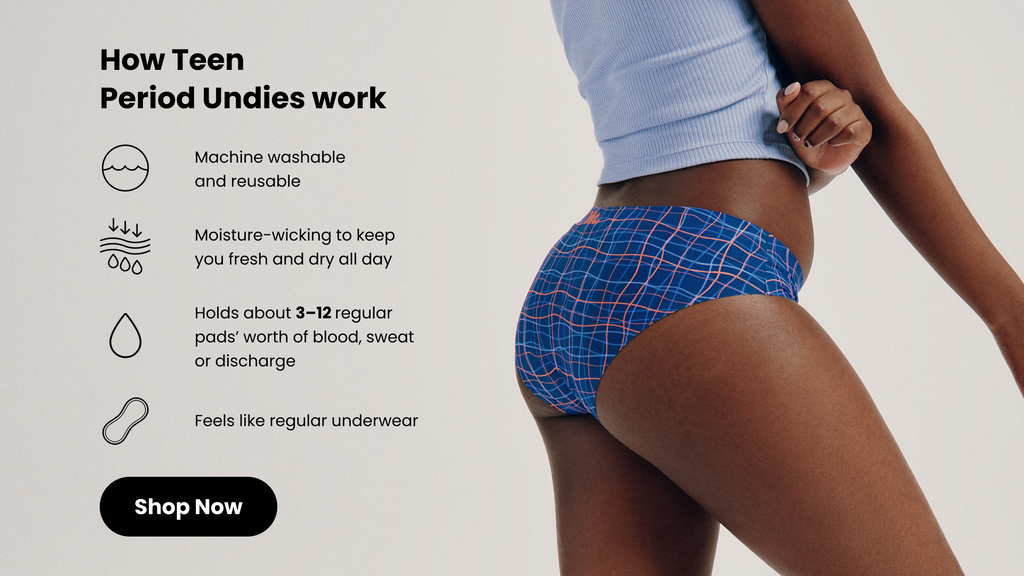While we’re still far from where we need to be to achieve period equity worldwide, our society has come a long way in terms of knowledge about menstruation and the products we use to manage our monthly cycles. Today, we’re a click away from accurate information about menstrual health, we’re working towards smashing the stigmas associated with periods, and we have better access than ever before to a diverse range of period products to fit the needs of everyone who menstruates. But your teen might be shocked to know that even as recently as our own parents’ first periods, things looked very different. And what about before that? How have periods changed through the ages? Let’s talk about the history of menstruation!
Pro-tip: Look to the future of period care and shop Kt's leakproof period underwear. Your teen will thank you.
Ancient Attitudes
Let’s take it all the way back to our first recorded mentions of menstruation: ancient civilizations. It’s important to note that up until very recent history, the only people who had the education, power and influence to be writing and recording history were men. Because cis-gendered men don’t experience menstruation, we have very little recorded knowledge about periods, and what we do have might strike you as a little silly.
Back in the day, Roman philosopher Pliny the Elder was convinced that periods were some kind of magical sorcery. He wrote that people on their periods could kill entire fields of crops, cause bees to leave their hives, and control the weather. While it’s clear that our pal Pliny was wrong, it goes to show how menstruation was thought of as this mystical thing to be feared, not the natural part of life we now know it to be. That said, I wouldn’t mind being a weather-controlling superhero once a month!

Medieval Menstruation
Unfortunately, attitudes towards menstruation weren’t much better in medieval times. Religious shame caused people to go to great lengths to hide their periods, and even believed that cramps were a divine punishment for Eve’s original sin. Since cramps were seen as a punishment, people who were menstruating weren’t offered pain relief medicine (mostly herbal remedies at the time). In an effort to ease some of the pain, people believed that burning a toad and wearing the ashes in a pouch around your waist would cure cramps. I don’t know about you, but I’m feeling really thankful for heating pads and ibuprofen right about now!
In medieval times, people would either use rags to absorb their period blood (ever wonder where the phrase “on the rag” came from?) or they would free bleed.

The Victorian Period (And Beyond)
In the late 19th century, periods entered their Bridgerton era and we saw the invention of the first menstrual products. From the 1890s to the early 1980s, people used sanitary belts, which basically were reusable pads that attached to a belt worn around the waist – and yes, they were as uncomfortable as they sound. While the reusable pad part was actually a pretty good idea, the belts were bulky and leakage was common.
The first disposable pads hit the market in 1888 (Lister’s Towels by Johnson & Johnson), and in the early 20th century, WW1 nurses used cellulose bandages in place of their reusable ones. The belts stuck around, though, to hold the disposable pads in place.
The first tampons came on the scene in the 1930s and aside from updating applicators over the years, the basic technology behind tampons hasn’t changed that much since.
Modern Menstruation
In the 1970s, brands began to release adhesive disposable pads, similar to what we see in the menstrual products aisle today. At first, adhesive pads were pretty bulky and uncomfy to wear, but a step up from having to suspend your pad from a belt.
Today, we still have disposable pads and tampons, but they’ve been tweaked over the years to be more absorbent, more comfortable, and more versatile, with products offered for different absorbency levels depending on your flow.
More recently, people have recognized the environmental and financial benefits of going back to reusable period products, like menstrual cups and products like Kt’s reusable pads, and period underwear. Ultimately, you have more freedom than ever before to explore your options and find the period product (or combination of products!) that works the best for you and your body.




